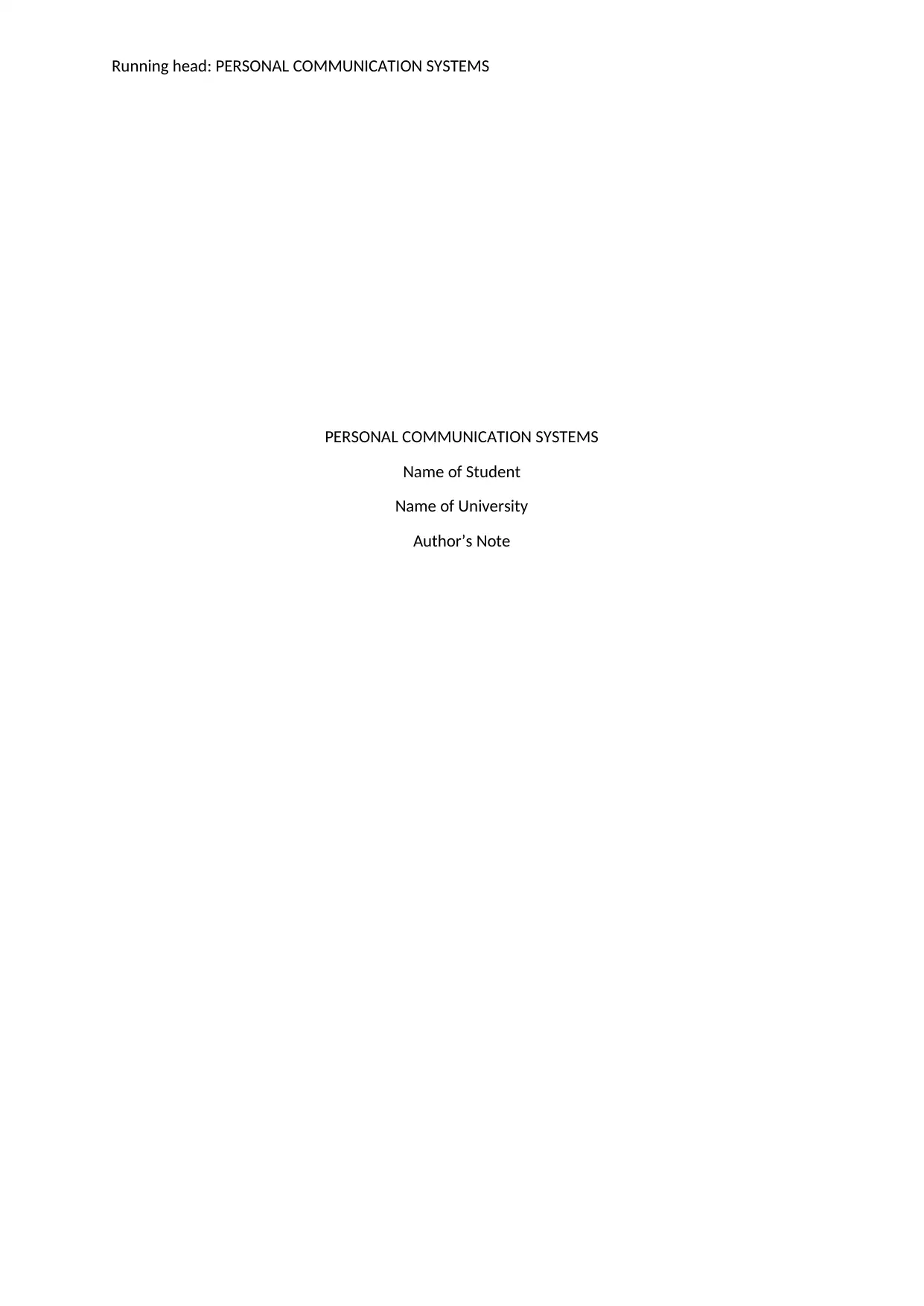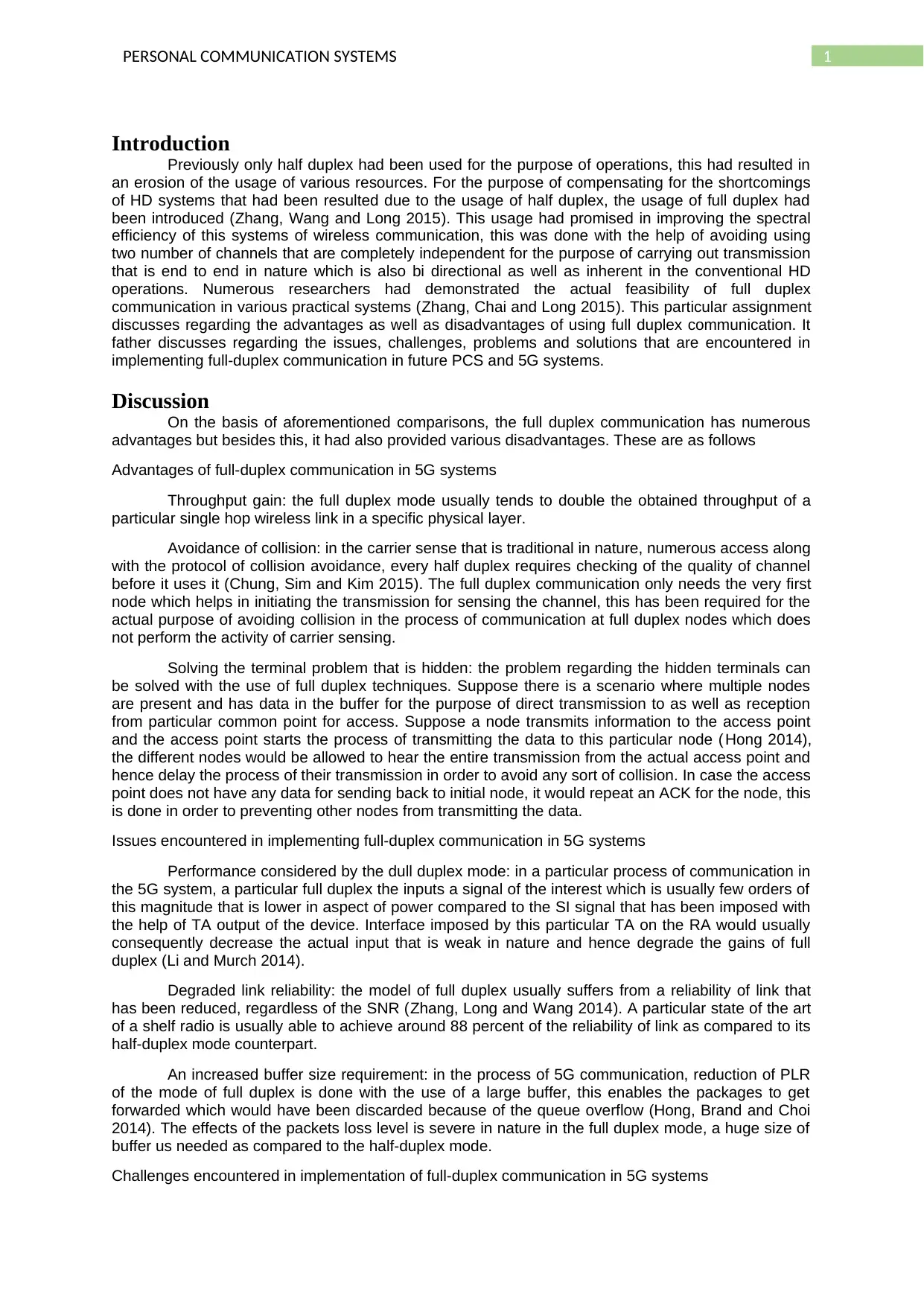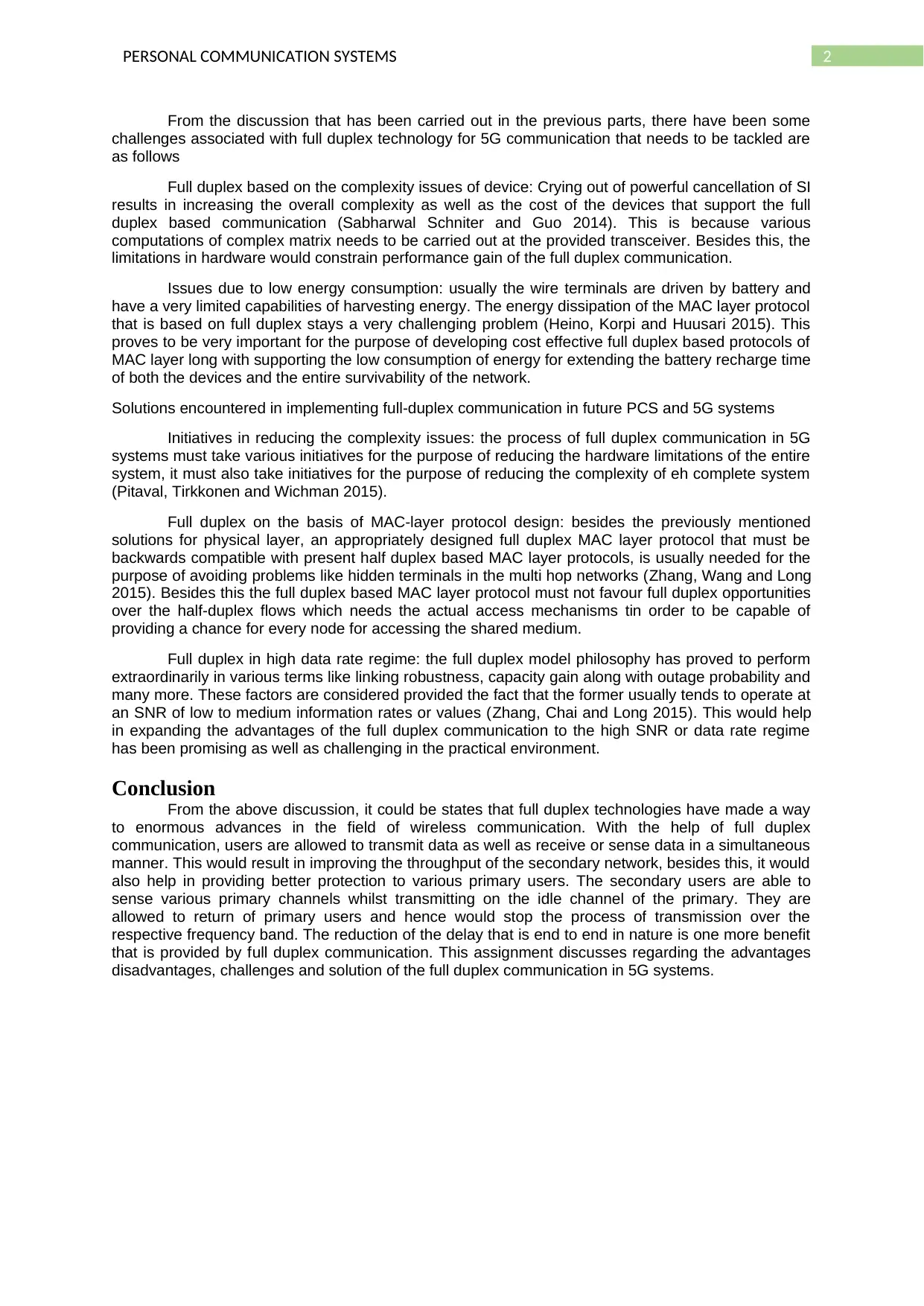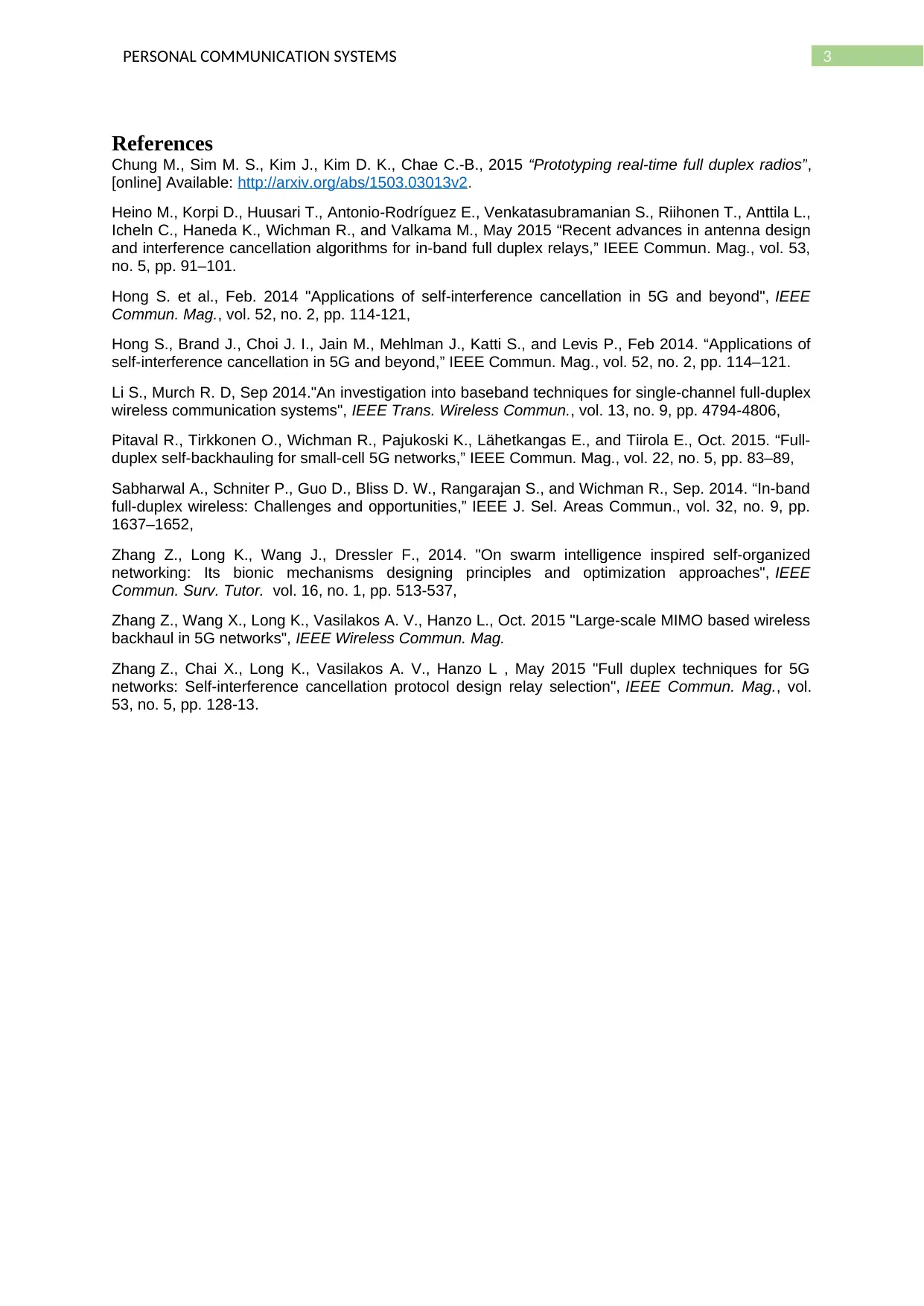Full Duplex Wireless Communication Issues in 5G Systems: WSU
VerifiedAdded on 2023/03/31
|4
|1683
|124
Report
AI Summary
This report discusses full-duplex communication in 5G systems, contrasting it with half-duplex systems and highlighting its potential to improve spectral efficiency. It details the advantages of full-duplex, such as throughput gain and collision avoidance, and addresses the challenges in implementation, including performance degradation and increased buffer size requirements. The report further explores solutions for future PCS and 5G systems, including complexity reduction and MAC-layer protocol design, concluding that full-duplex technologies offer significant advances in wireless communication by enabling simultaneous data transmission and reception, improving network throughput, and reducing end-to-end delay.

Running head: PERSONAL COMMUNICATION SYSTEMS
PERSONAL COMMUNICATION SYSTEMS
Name of Student
Name of University
Author’s Note
PERSONAL COMMUNICATION SYSTEMS
Name of Student
Name of University
Author’s Note
Paraphrase This Document
Need a fresh take? Get an instant paraphrase of this document with our AI Paraphraser

1PERSONAL COMMUNICATION SYSTEMS
Introduction
Previously only half duplex had been used for the purpose of operations, this had resulted in
an erosion of the usage of various resources. For the purpose of compensating for the shortcomings
of HD systems that had been resulted due to the usage of half duplex, the usage of full duplex had
been introduced (Zhang, Wang and Long 2015). This usage had promised in improving the spectral
efficiency of this systems of wireless communication, this was done with the help of avoiding using
two number of channels that are completely independent for the purpose of carrying out transmission
that is end to end in nature which is also bi directional as well as inherent in the conventional HD
operations. Numerous researchers had demonstrated the actual feasibility of full duplex
communication in various practical systems (Zhang, Chai and Long 2015). This particular assignment
discusses regarding the advantages as well as disadvantages of using full duplex communication. It
father discusses regarding the issues, challenges, problems and solutions that are encountered in
implementing full-duplex communication in future PCS and 5G systems.
Discussion
On the basis of aforementioned comparisons, the full duplex communication has numerous
advantages but besides this, it had also provided various disadvantages. These are as follows
Advantages of full-duplex communication in 5G systems
Throughput gain: the full duplex mode usually tends to double the obtained throughput of a
particular single hop wireless link in a specific physical layer.
Avoidance of collision: in the carrier sense that is traditional in nature, numerous access along
with the protocol of collision avoidance, every half duplex requires checking of the quality of channel
before it uses it (Chung, Sim and Kim 2015). The full duplex communication only needs the very first
node which helps in initiating the transmission for sensing the channel, this has been required for the
actual purpose of avoiding collision in the process of communication at full duplex nodes which does
not perform the activity of carrier sensing.
Solving the terminal problem that is hidden: the problem regarding the hidden terminals can
be solved with the use of full duplex techniques. Suppose there is a scenario where multiple nodes
are present and has data in the buffer for the purpose of direct transmission to as well as reception
from particular common point for access. Suppose a node transmits information to the access point
and the access point starts the process of transmitting the data to this particular node ( Hong 2014),
the different nodes would be allowed to hear the entire transmission from the actual access point and
hence delay the process of their transmission in order to avoid any sort of collision. In case the access
point does not have any data for sending back to initial node, it would repeat an ACK for the node, this
is done in order to preventing other nodes from transmitting the data.
Issues encountered in implementing full-duplex communication in 5G systems
Performance considered by the dull duplex mode: in a particular process of communication in
the 5G system, a particular full duplex the inputs a signal of the interest which is usually few orders of
this magnitude that is lower in aspect of power compared to the SI signal that has been imposed with
the help of TA output of the device. Interface imposed by this particular TA on the RA would usually
consequently decrease the actual input that is weak in nature and hence degrade the gains of full
duplex (Li and Murch 2014).
Degraded link reliability: the model of full duplex usually suffers from a reliability of link that
has been reduced, regardless of the SNR (Zhang, Long and Wang 2014). A particular state of the art
of a shelf radio is usually able to achieve around 88 percent of the reliability of link as compared to its
half-duplex mode counterpart.
An increased buffer size requirement: in the process of 5G communication, reduction of PLR
of the mode of full duplex is done with the use of a large buffer, this enables the packages to get
forwarded which would have been discarded because of the queue overflow (Hong, Brand and Choi
2014). The effects of the packets loss level is severe in nature in the full duplex mode, a huge size of
buffer us needed as compared to the half-duplex mode.
Challenges encountered in implementation of full-duplex communication in 5G systems
Introduction
Previously only half duplex had been used for the purpose of operations, this had resulted in
an erosion of the usage of various resources. For the purpose of compensating for the shortcomings
of HD systems that had been resulted due to the usage of half duplex, the usage of full duplex had
been introduced (Zhang, Wang and Long 2015). This usage had promised in improving the spectral
efficiency of this systems of wireless communication, this was done with the help of avoiding using
two number of channels that are completely independent for the purpose of carrying out transmission
that is end to end in nature which is also bi directional as well as inherent in the conventional HD
operations. Numerous researchers had demonstrated the actual feasibility of full duplex
communication in various practical systems (Zhang, Chai and Long 2015). This particular assignment
discusses regarding the advantages as well as disadvantages of using full duplex communication. It
father discusses regarding the issues, challenges, problems and solutions that are encountered in
implementing full-duplex communication in future PCS and 5G systems.
Discussion
On the basis of aforementioned comparisons, the full duplex communication has numerous
advantages but besides this, it had also provided various disadvantages. These are as follows
Advantages of full-duplex communication in 5G systems
Throughput gain: the full duplex mode usually tends to double the obtained throughput of a
particular single hop wireless link in a specific physical layer.
Avoidance of collision: in the carrier sense that is traditional in nature, numerous access along
with the protocol of collision avoidance, every half duplex requires checking of the quality of channel
before it uses it (Chung, Sim and Kim 2015). The full duplex communication only needs the very first
node which helps in initiating the transmission for sensing the channel, this has been required for the
actual purpose of avoiding collision in the process of communication at full duplex nodes which does
not perform the activity of carrier sensing.
Solving the terminal problem that is hidden: the problem regarding the hidden terminals can
be solved with the use of full duplex techniques. Suppose there is a scenario where multiple nodes
are present and has data in the buffer for the purpose of direct transmission to as well as reception
from particular common point for access. Suppose a node transmits information to the access point
and the access point starts the process of transmitting the data to this particular node ( Hong 2014),
the different nodes would be allowed to hear the entire transmission from the actual access point and
hence delay the process of their transmission in order to avoid any sort of collision. In case the access
point does not have any data for sending back to initial node, it would repeat an ACK for the node, this
is done in order to preventing other nodes from transmitting the data.
Issues encountered in implementing full-duplex communication in 5G systems
Performance considered by the dull duplex mode: in a particular process of communication in
the 5G system, a particular full duplex the inputs a signal of the interest which is usually few orders of
this magnitude that is lower in aspect of power compared to the SI signal that has been imposed with
the help of TA output of the device. Interface imposed by this particular TA on the RA would usually
consequently decrease the actual input that is weak in nature and hence degrade the gains of full
duplex (Li and Murch 2014).
Degraded link reliability: the model of full duplex usually suffers from a reliability of link that
has been reduced, regardless of the SNR (Zhang, Long and Wang 2014). A particular state of the art
of a shelf radio is usually able to achieve around 88 percent of the reliability of link as compared to its
half-duplex mode counterpart.
An increased buffer size requirement: in the process of 5G communication, reduction of PLR
of the mode of full duplex is done with the use of a large buffer, this enables the packages to get
forwarded which would have been discarded because of the queue overflow (Hong, Brand and Choi
2014). The effects of the packets loss level is severe in nature in the full duplex mode, a huge size of
buffer us needed as compared to the half-duplex mode.
Challenges encountered in implementation of full-duplex communication in 5G systems

2PERSONAL COMMUNICATION SYSTEMS
From the discussion that has been carried out in the previous parts, there have been some
challenges associated with full duplex technology for 5G communication that needs to be tackled are
as follows
Full duplex based on the complexity issues of device: Crying out of powerful cancellation of SI
results in increasing the overall complexity as well as the cost of the devices that support the full
duplex based communication (Sabharwal Schniter and Guo 2014). This is because various
computations of complex matrix needs to be carried out at the provided transceiver. Besides this, the
limitations in hardware would constrain performance gain of the full duplex communication.
Issues due to low energy consumption: usually the wire terminals are driven by battery and
have a very limited capabilities of harvesting energy. The energy dissipation of the MAC layer protocol
that is based on full duplex stays a very challenging problem (Heino, Korpi and Huusari 2015). This
proves to be very important for the purpose of developing cost effective full duplex based protocols of
MAC layer long with supporting the low consumption of energy for extending the battery recharge time
of both the devices and the entire survivability of the network.
Solutions encountered in implementing full-duplex communication in future PCS and 5G systems
Initiatives in reducing the complexity issues: the process of full duplex communication in 5G
systems must take various initiatives for the purpose of reducing the hardware limitations of the entire
system, it must also take initiatives for the purpose of reducing the complexity of eh complete system
(Pitaval, Tirkkonen and Wichman 2015).
Full duplex on the basis of MAC-layer protocol design: besides the previously mentioned
solutions for physical layer, an appropriately designed full duplex MAC layer protocol that must be
backwards compatible with present half duplex based MAC layer protocols, is usually needed for the
purpose of avoiding problems like hidden terminals in the multi hop networks (Zhang, Wang and Long
2015). Besides this the full duplex based MAC layer protocol must not favour full duplex opportunities
over the half-duplex flows which needs the actual access mechanisms tin order to be capable of
providing a chance for every node for accessing the shared medium.
Full duplex in high data rate regime: the full duplex model philosophy has proved to perform
extraordinarily in various terms like linking robustness, capacity gain along with outage probability and
many more. These factors are considered provided the fact that the former usually tends to operate at
an SNR of low to medium information rates or values (Zhang, Chai and Long 2015). This would help
in expanding the advantages of the full duplex communication to the high SNR or data rate regime
has been promising as well as challenging in the practical environment.
Conclusion
From the above discussion, it could be states that full duplex technologies have made a way
to enormous advances in the field of wireless communication. With the help of full duplex
communication, users are allowed to transmit data as well as receive or sense data in a simultaneous
manner. This would result in improving the throughput of the secondary network, besides this, it would
also help in providing better protection to various primary users. The secondary users are able to
sense various primary channels whilst transmitting on the idle channel of the primary. They are
allowed to return of primary users and hence would stop the process of transmission over the
respective frequency band. The reduction of the delay that is end to end in nature is one more benefit
that is provided by full duplex communication. This assignment discusses regarding the advantages
disadvantages, challenges and solution of the full duplex communication in 5G systems.
From the discussion that has been carried out in the previous parts, there have been some
challenges associated with full duplex technology for 5G communication that needs to be tackled are
as follows
Full duplex based on the complexity issues of device: Crying out of powerful cancellation of SI
results in increasing the overall complexity as well as the cost of the devices that support the full
duplex based communication (Sabharwal Schniter and Guo 2014). This is because various
computations of complex matrix needs to be carried out at the provided transceiver. Besides this, the
limitations in hardware would constrain performance gain of the full duplex communication.
Issues due to low energy consumption: usually the wire terminals are driven by battery and
have a very limited capabilities of harvesting energy. The energy dissipation of the MAC layer protocol
that is based on full duplex stays a very challenging problem (Heino, Korpi and Huusari 2015). This
proves to be very important for the purpose of developing cost effective full duplex based protocols of
MAC layer long with supporting the low consumption of energy for extending the battery recharge time
of both the devices and the entire survivability of the network.
Solutions encountered in implementing full-duplex communication in future PCS and 5G systems
Initiatives in reducing the complexity issues: the process of full duplex communication in 5G
systems must take various initiatives for the purpose of reducing the hardware limitations of the entire
system, it must also take initiatives for the purpose of reducing the complexity of eh complete system
(Pitaval, Tirkkonen and Wichman 2015).
Full duplex on the basis of MAC-layer protocol design: besides the previously mentioned
solutions for physical layer, an appropriately designed full duplex MAC layer protocol that must be
backwards compatible with present half duplex based MAC layer protocols, is usually needed for the
purpose of avoiding problems like hidden terminals in the multi hop networks (Zhang, Wang and Long
2015). Besides this the full duplex based MAC layer protocol must not favour full duplex opportunities
over the half-duplex flows which needs the actual access mechanisms tin order to be capable of
providing a chance for every node for accessing the shared medium.
Full duplex in high data rate regime: the full duplex model philosophy has proved to perform
extraordinarily in various terms like linking robustness, capacity gain along with outage probability and
many more. These factors are considered provided the fact that the former usually tends to operate at
an SNR of low to medium information rates or values (Zhang, Chai and Long 2015). This would help
in expanding the advantages of the full duplex communication to the high SNR or data rate regime
has been promising as well as challenging in the practical environment.
Conclusion
From the above discussion, it could be states that full duplex technologies have made a way
to enormous advances in the field of wireless communication. With the help of full duplex
communication, users are allowed to transmit data as well as receive or sense data in a simultaneous
manner. This would result in improving the throughput of the secondary network, besides this, it would
also help in providing better protection to various primary users. The secondary users are able to
sense various primary channels whilst transmitting on the idle channel of the primary. They are
allowed to return of primary users and hence would stop the process of transmission over the
respective frequency band. The reduction of the delay that is end to end in nature is one more benefit
that is provided by full duplex communication. This assignment discusses regarding the advantages
disadvantages, challenges and solution of the full duplex communication in 5G systems.
⊘ This is a preview!⊘
Do you want full access?
Subscribe today to unlock all pages.

Trusted by 1+ million students worldwide

3PERSONAL COMMUNICATION SYSTEMS
References
Chung M., Sim M. S., Kim J., Kim D. K., Chae C.-B., 2015 “Prototyping real-time full duplex radios”,
[online] Available: http://arxiv.org/abs/1503.03013v2.
Heino M., Korpi D., Huusari T., Antonio-Rodríguez E., Venkatasubramanian S., Riihonen T., Anttila L.,
Icheln C., Haneda K., Wichman R., and Valkama M., May 2015 “Recent advances in antenna design
and interference cancellation algorithms for in-band full duplex relays,” IEEE Commun. Mag., vol. 53,
no. 5, pp. 91–101.
Hong S. et al., Feb. 2014 "Applications of self-interference cancellation in 5G and beyond", IEEE
Commun. Mag., vol. 52, no. 2, pp. 114-121,
Hong S., Brand J., Choi J. I., Jain M., Mehlman J., Katti S., and Levis P., Feb 2014. “Applications of
self-interference cancellation in 5G and beyond,” IEEE Commun. Mag., vol. 52, no. 2, pp. 114–121.
Li S., Murch R. D, Sep 2014."An investigation into baseband techniques for single-channel full-duplex
wireless communication systems", IEEE Trans. Wireless Commun., vol. 13, no. 9, pp. 4794-4806,
Pitaval R., Tirkkonen O., Wichman R., Pajukoski K., Lähetkangas E., and Tiirola E., Oct. 2015. “Full-
duplex self-backhauling for small-cell 5G networks,” IEEE Commun. Mag., vol. 22, no. 5, pp. 83–89,
Sabharwal A., Schniter P., Guo D., Bliss D. W., Rangarajan S., and Wichman R., Sep. 2014. “In-band
full-duplex wireless: Challenges and opportunities,” IEEE J. Sel. Areas Commun., vol. 32, no. 9, pp.
1637–1652,
Zhang Z., Long K., Wang J., Dressler F., 2014. "On swarm intelligence inspired self-organized
networking: Its bionic mechanisms designing principles and optimization approaches", IEEE
Commun. Surv. Tutor. vol. 16, no. 1, pp. 513-537,
Zhang Z., Wang X., Long K., Vasilakos A. V., Hanzo L., Oct. 2015 "Large-scale MIMO based wireless
backhaul in 5G networks", IEEE Wireless Commun. Mag.
Zhang Z., Chai X., Long K., Vasilakos A. V., Hanzo L , May 2015 "Full duplex techniques for 5G
networks: Self-interference cancellation protocol design relay selection", IEEE Commun. Mag., vol.
53, no. 5, pp. 128-13.
References
Chung M., Sim M. S., Kim J., Kim D. K., Chae C.-B., 2015 “Prototyping real-time full duplex radios”,
[online] Available: http://arxiv.org/abs/1503.03013v2.
Heino M., Korpi D., Huusari T., Antonio-Rodríguez E., Venkatasubramanian S., Riihonen T., Anttila L.,
Icheln C., Haneda K., Wichman R., and Valkama M., May 2015 “Recent advances in antenna design
and interference cancellation algorithms for in-band full duplex relays,” IEEE Commun. Mag., vol. 53,
no. 5, pp. 91–101.
Hong S. et al., Feb. 2014 "Applications of self-interference cancellation in 5G and beyond", IEEE
Commun. Mag., vol. 52, no. 2, pp. 114-121,
Hong S., Brand J., Choi J. I., Jain M., Mehlman J., Katti S., and Levis P., Feb 2014. “Applications of
self-interference cancellation in 5G and beyond,” IEEE Commun. Mag., vol. 52, no. 2, pp. 114–121.
Li S., Murch R. D, Sep 2014."An investigation into baseband techniques for single-channel full-duplex
wireless communication systems", IEEE Trans. Wireless Commun., vol. 13, no. 9, pp. 4794-4806,
Pitaval R., Tirkkonen O., Wichman R., Pajukoski K., Lähetkangas E., and Tiirola E., Oct. 2015. “Full-
duplex self-backhauling for small-cell 5G networks,” IEEE Commun. Mag., vol. 22, no. 5, pp. 83–89,
Sabharwal A., Schniter P., Guo D., Bliss D. W., Rangarajan S., and Wichman R., Sep. 2014. “In-band
full-duplex wireless: Challenges and opportunities,” IEEE J. Sel. Areas Commun., vol. 32, no. 9, pp.
1637–1652,
Zhang Z., Long K., Wang J., Dressler F., 2014. "On swarm intelligence inspired self-organized
networking: Its bionic mechanisms designing principles and optimization approaches", IEEE
Commun. Surv. Tutor. vol. 16, no. 1, pp. 513-537,
Zhang Z., Wang X., Long K., Vasilakos A. V., Hanzo L., Oct. 2015 "Large-scale MIMO based wireless
backhaul in 5G networks", IEEE Wireless Commun. Mag.
Zhang Z., Chai X., Long K., Vasilakos A. V., Hanzo L , May 2015 "Full duplex techniques for 5G
networks: Self-interference cancellation protocol design relay selection", IEEE Commun. Mag., vol.
53, no. 5, pp. 128-13.
1 out of 4
Related Documents
Your All-in-One AI-Powered Toolkit for Academic Success.
+13062052269
info@desklib.com
Available 24*7 on WhatsApp / Email
![[object Object]](/_next/static/media/star-bottom.7253800d.svg)
Unlock your academic potential
Copyright © 2020–2025 A2Z Services. All Rights Reserved. Developed and managed by ZUCOL.




